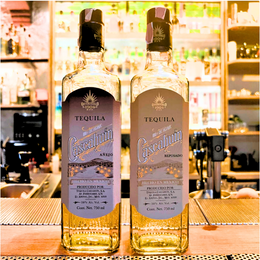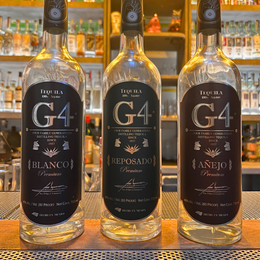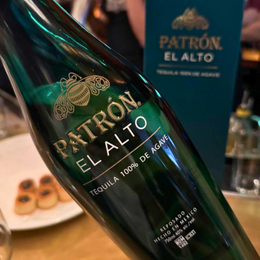Taste Testing The Bar Industry's Darling Craft Tequila: Fortaleza Blanco & Fortaleza Reposado

Fortaleza Tequila isn’t the biggest tequila brand but it’s a darling name of the American bar scene with the respect of both tequila enthusiasts and discerning bartenders – whether they’re shaking up a Margarita, or just looking for a decent neat sipping tequila.
Although the brand was launched in 2005 by Guillermo Erickson Sauza, its real story began over a century earlier in 1873, with his great-great-great grandfather, Don Cenobio Sauza who founded the famous Sauza Tequila brand still popular today.

Don Cenobio who founded Sauza Tequila, which was eventually sold.

Don Cenobio is something of a pioneering figure in tequila history. While agave-based alcoholic drinks had existed for centuries, Don Cenobio was the first to export "mezcal de tequila" to the United States, essentially introducing tequila to the world beyond Mexico. He also had a keen eye for quality and innovation, pioneering several changes to the production process that helped shape the modern tequila production. He was the first to use steam ovens to cook the agave, a move away from the traditional earthen pits still used for traditional mezcal today. This seemingly small change resulted in a tequila with a cleaner, more refined flavour profile. He also championed the use of Blue Weber agave, after much experimentation with different varietals, recognising its superior quality for tequila production. The use of Blue Weber is, of course, now a requirement for any spirit that wants to call itself "tequila".

Don Eladio.
The tequila torch then passed down through the generations. Don Cenobio's son, Don Eladio, took the reins of the family business and expanded tequila exports globally. He was a savvy businessman who navigated the turbulent years of the Mexican Revolution, even managing to position tequila as Mexico's national drink.

Don Javier and his son, Guillermo - who would go on to found Fortaleza Tequila.
And then there's his son who came after, Don Javier, who was a marketing maestro in his own right. He made the Sauza brand a household name in the US, achieving the kind of celebrity endorsement most brands can only dream of: in an interview with Esquire magazine, 1940s’ Hollywood icon John Wayne himself declared that his favourite drink was a Sauza Commemorativa Tequila on the rocks with a twist of lemon.

(Source: John Wayne Official)
Continuing his great grandfather’s work, Don Javier also worked on protecting the heritage of tequila. Starting in the 1970s, he led a group of tequila producers in lobbying for the tequila appellation of origin, a designation that would ensure that any spirit labelled "tequila" must be made according to certain specifications and made in Mexico, specifically in the area in and around Tequila. It was a long battle, and it wasn't until 1996 that the official Denomination of Origin was finally established, but Don Javier's efforts were instrumental in its success.
Just as things seemed to be going swimmingly for Sauza Tequila, a bombshell dropped in 1976. Don Javier – to the surprise of the industry and tequila lovers – decided to sell the Sauza brand to Jim Beam. Guillermo, Don Javier's grandson who was 20 at the time, was taken aback by the news himself. He had grown up immersed in the world of tequila, surrounded by the sights, sounds and smells of the family distillery.

But Guillermo continued to be passionate about tequila. Despite the sale of the Sauza brand, the family actually retained some land and one of their original distilleries, La Fortaleza. This gave Guillermo a glimmer of hope.
In 1999, Guillermo embarked on a mission to restore the dilapidated distillery. He dusted off old distillation equipment from Don Cenobio's time, and brought the distillery back to life. By 2005, the distillery was back in operation, and Guillermo’s new tequila brand was born. His vision was clear: he aimed to produce tequila using the same traditional methods passed down through generations.

And that's precisely what makes Fortaleza stand out in the market. They use an ancestral tequila-making technique called Tahona Method for crushing the cooked agave. This technique involves a large, two-ton volcanic stone – called a tahona, pulled by a tractor, which slowly crushes the agave fibres, extracting the sugars within. It's a labour-intensive process that many larger distilleries have abandoned in favour of more efficient, mechanised methods. However, the this method leaves some of the agave's natural sugars behind, adding to the richness of the final product. Fortaleza believes that the Tahona Method yields a final tequila product with greater depth of flavour and complexity.

After fermentation, the liquid, known as mosto, is distilled twice in traditional copper pot stills. These stills are said to have been in the distillery for over a century. And interestingly, Fortaleza's stills produce tequila at an unusually low ABV of around 45% after the first round of distillation. In contrast, other tequila producers tend to produce off the still at 55% to 75% ABV. This lower ABV means that less water is needed to dilute the tequila to its bottling strength of 40%, resulting in a purer agave flavour.

The company is also committed to sourcing high-quality agave, working with small local farmers and also cultivating agave on their own estate. And, of course, like all good tequilas, Fortaleza is made with 100% Blue Weber agave, with no corn syrup or sugar added during fermentation, and the final product is additive-free.

The Fortaleza range includes four expressions: Blanco, Reposado, Añejo and Still Strength. The Reposado and Añejo are aged in used American oak barrels.

Now, here's a bit of a branding quirk. Fortaleza actually has two brand names. Internationally, it's known as Fortaleza, which translates to "fortitude" in Spanish. But in Mexico, it's called "Los Abuelos," meaning "The Grandfathers." Guillermo initially wanted to use this name as a tribute to his ancestors and their traditional tequila-making methods. However, they apparently ran into a trademark issue in the United States due to the existing Ron Abuelo Rum brand. Thus, Fortaleza the brand was born for the international market.
We’re having two bottles of Fortaleza here tasted at the up-and-coming agave spirit-forward bar Cat Bite Club in Singapore. Let’s give them a taste ourselves!
Fortaleza Blanco Tequila, 40% ABV – Review

Tasting Notes
Nose: On the nose, the tequila is quite fresh and filled with succulent vegetables: smashed cucumbers, Filipino boiled wintermelon, steamed eggplant, fresh lettuce leaves and sliced cabbage. It’s neither too roasty nor smoky. After letting it sit for a short while, fruiter aromas develop within the glass, reading of sliced apples and peach.
Palate: Crisp, airy and light on texture, with a gentle, slightly citrusy acidity. It first gives a sweet vegetal flavour, like boiled or simmered cabbage and radish chunks, then gradually developing into slightly roastier, more savory flavours of pan fried brussel sprouts and roasted cauliflower.
Finish: The finish is slightly spicy with a mild smoky aroma, giving clean herbaceous aromas and flavours of oregano, the menthol-like character of fennel seeds and the spicy nuttiness of cumin. It develops some more dried mint notes as well, with a lasting aftertaste of that herbaceous, slightly grassy and stalky flavour of dried mint leaves that have a subdued cooling effect.

My Thoughts:
The Blanco has a very crisp, fresh, balanced quality, with a rather pure vegetal agave essence to it. The focus is on a minty, drying profile that reads a variety of big, chunky vegetables, with a distinctive but mild smoke or roastiness that makes for very easy drinking. It has a herbaceous sweetness to it, though there isn’t much in the way of fruity aromas or sweetness.
This is a straightforward and well-balanced sipping tequila that offers up the unadulterated natural sweetness of the agave in its most organic form.
Fortaleza Reposado Tequila, 40% ABV – Review

Tasting Notes
Nose: Mellow on the nose but significantly sweeter with caster sugar and mild baking spices: freshly shaved nutmeg, ground allspice, pops of cloves and sweetness of vanilla essence. There is a slight dried tropical fruit character to the tequila on the nose, like dried figs and banana chips.
Palate: Reflects much of what is on the nose, with the same mild baking spices coming forth at first; this time sweeter and gentler like cassia, star anise, and freshly shaved nutmeg. There is a spicy rootiness to the tequila here as well, with the volatility of young ginger and the denseness of fresh turmeric mixed together. There is a mild sweetness and freshness in the way of fruit flavours, mainly sliced apples and pears that has had a dusting of cinnamon or allspice powder.
Finish: The finish is spicier and slightly more fiery, with fresh mace, sliced ginger and hints of the piney, herbaceous notes of galangal. After the initial wave of spiced ginger notes, it tunes down towards roasted vegetables: roasted eggplant, tomatillos and cucumbers. The finish does not stay for long, leaving ground nutmeg as it tails off.

My Thoughts:
This Reposado is also really easy drinking as the Blanco, with lovely accents of wood spice. It’s smooth and well balanced, with much of the clean agave notes of the earlier expression remaining intact, but now accented with a soft oakiness. We get a fairly dry profile with chunky vegetal nuances, but this time with a mild dried tropical fruit sweetness on the aroma. The texture is slightly thicker and oilier this time.
And while it is slightly sweeter on the aroma, it is not so on the palate. You do not get those cloying sweet or spicy flavours, just enough to offer some contrast with the vegetal profile of the tequila. Oak aging seems to have offered some decent complexity in the way that different spices pop in and out of your palate through the tasting.
This makes for a very versatile expression – one that you could enjoy as a sipping tequila but clean enough still to be used in a nice Paloma – the slight sweetness and vanilla accents here would balance out the tartness of the grapefruit.
Final Thoughts
For many of us, the first impression of Fortaleza would be that realization of its restraint when it comes to sweetness. Unlike many widely commercialized tequilas that lean on added sugars or sweeteners, Fortaleza takes a different approach – a commitment to purity that is precisely why connoisseurs and bartenders hold this brand in high regard.

Both the Blanco and Reposado offer a pretty authentic experience. The focus is on allowing the natural flavors of the agave to shine through without being masked by excessive sweetness or oakiness. This purity, combined with excellent balance and drinkability, makes them both a joy to sip on their own. It’s also a mindful reminder to appreciate things like raw sashimi, dark chocolate or unsweetened tea, and a way to train our palates to discern the complexity and depth that an authentic tequila can offer.
Both are fantastic choices for those looking to taste the unadulterated sweetness of agave. For those who are familiar with whisky, I’m inclined to recommend the Reposado which offer a slightly more familiar dimension of wood spice and vanilla notes.

@CharsiuCharlie







